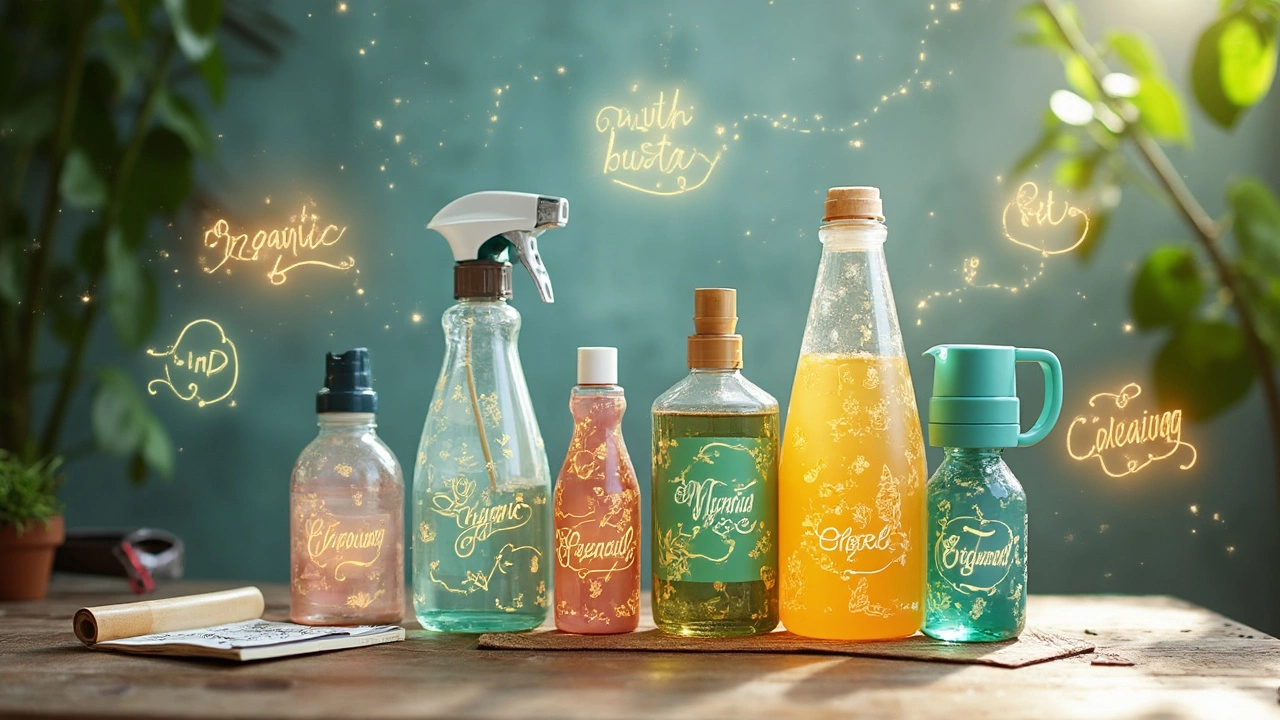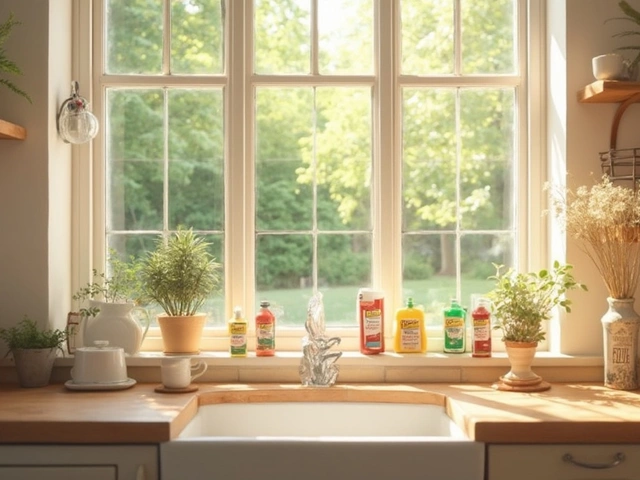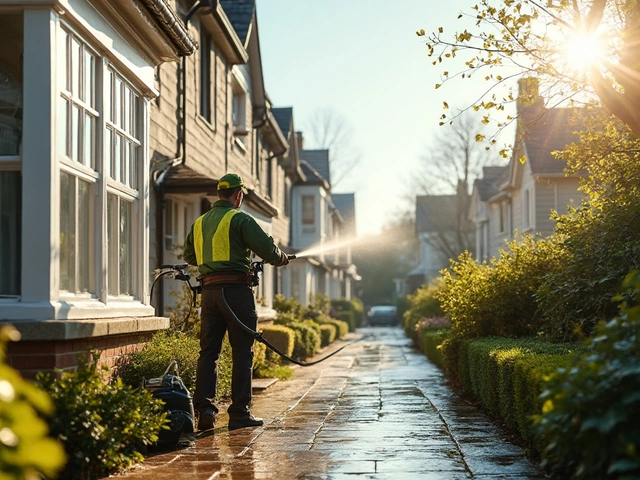Ever looked at two bottles of cleaner—one saying “eco-friendly” and the other “organic”—and wondered if they’re just fancy ways to say the same thing? It’s easy to get lost in the sea of green labels, especially when brands love to slap on anything that sounds good. But here’s the deal: eco-friendly and organic don’t actually mean the same thing, not even close.
Think about it like food labels. An apple can be organic (grown without synthetic chemicals), but it’s only eco-friendly if the farming also protects the soil, water, and wildlife. Cleaning products work the same way: organic focuses on how the ingredients are grown or made, while eco-friendly is about the product’s entire impact, from chemicals to packaging to water use.
The kicker is, some “eco-friendly” products still use ingredients you’d never want near your pets or your skin. Sable, my dog, once pawed at a “green” floor cleaner and ended up itchy—proof that labels don’t always tell the whole truth. So what you use at home isn’t just about being trendy; it really does matter to your health and the planet. Keep reading, and you’ll see what separates eco-friendly from organic—and how you can spot the difference next time you’re stuck in the cleaning aisle.
- Eco-Friendly and Organic: The Label Showdown
- Ingredients Under the Microscope
- How Certifications Work (and When They Don’t)
- Are Eco-Friendly Cleaning Products Better for You?
- Common Misconceptions and Marketing Tricks
- Tips for Smarter, Greener Shopping
Eco-Friendly and Organic: The Label Showdown
Let’s get straight to it. The words “eco-friendly” and “organic” sound similar, but when you’re shopping for eco-friendly cleaning products, you need to know exactly what each label really means. It’s not just marketing—they signal two different things.
"Organic" means the ingredients were grown or created without synthetic chemicals, pesticides, or genetically modified stuff. Certification matters here—products labeled organic should meet standards set by organizations like the USDA. For food, the rules are clear. For cleaners, it gets messy. The US doesn’t police organic cleaning claims as closely as it does food. So a cleaner might have some organic ingredients alongside not-so-organic ones.
"Eco-friendly" goes beyond just what’s inside the bottle. It says the product is made and used in a way that doesn’t mess up the environment—think less pollution, safer runoff into waterways, and packaging that’s recyclable or biodegradable. But here’s the catch: there aren’t strict government rules for who can slap “eco-friendly” on a cleaner’s label. Brands can call anything green, even if it’s not as gentle as they claim.
If you want specifics, here’s how the terms stack up:
| Term | What It Means | Common Issues |
|---|---|---|
| Eco-Friendly | Supposed to minimize harm to environment (low-tox, sustainable packaging, less waste) | Often not third-party verified, can be empty marketing |
| Organic | Contains ingredients grown without synthetic chemicals or pesticides | No universal rule for non-food items, organic % can be low |
So, when you pick up a “green” or “natural” cleaner, know this: eco-friendly is a promise about bigger-picture impact, while organic is specific to how something was made or grown. The overlap? Some products can be both, but not always. That’s why double-checking the back label and certifications is never a waste of time.
- If you see a credible third-party logo like EPA Safer Choice or USDA Organic on a cleaning product, that’s worth more than wording alone.
- Don’t assume an eco-friendly cleaner is free of synthetic stuff—always check the list of ingredients.
- Watch for “greenwashing”—products that look green but don’t actually stick to any clear eco or organic standards.
Ingredients Under the Microscope
If you peek at the back of an "eco-friendly" bottle and an "organic" one, the ingredient lists aren’t just a jumble of green promises—they actually show big differences. So what’s really inside these cleaners?
"Organic" cleaning products must use ingredients that come from plants or other natural sources, grown without synthetic pesticides or fertilizers. That means you’ll see things like organic lemon oil, organic vinegar, or coconut-derived surfactants. The point is there shouldn’t be any ingredients made in a lab out of petroleum byproducts.
"Eco-friendly" has a wider meaning. It focuses on the overall impact of the product. This might include biodegradable chemicals (which break down fast in nature), no phosphates (to keep water cleaner), or packaging made from recycled stuff. But—and this is a big deal—eco-friendly labels sometimes allow lab-made ingredients as long as they’re less toxic or break down faster than the old-school chemicals.
Let’s check out a quick rundown of common ingredients you might see, and what those really mean:
- Eco-friendly product: Biodegradable surfactants, plant-based solvents, citric acid, less packaging waste
- Organic product: Certified organic plant extracts, naturally fermented alcohol, essential oils, straightforward formulas
- Both: No artificial fragrances, no chlorine bleach, no phthalates or parabens
Want some numbers? A 2023 report showed about 35% of “green” cleaning brands in U.S. stores included at least one synthetic ingredient, even if the label looked planet-friendly. That’s why reading the label actually matters.
| Label Type | Allowed Ingredients | Typical Certifications |
|---|---|---|
| Organic | Certified organic plant-based, natural minerals, no synthetics | USDA Organic, ECOCERT |
| Eco-friendly | Some synthetic, biodegradable, recycled packaging | EPA Safer Choice, Green Seal |
The takeaway? Not all "green" claims are created equal. Flip those bottles over and actually look for proof, not just buzzwords. If something sounds too good to be true—a citrus cleaner that claims to whiten like bleach—it’s probably worth a closer look.
How Certifications Work (and When They Don’t)
Certifications on cleaning products can be confusing. You’ll see badges like “USDA Organic,” “EPA Safer Choice,” “EcoLogo,” or “Green Seal” all over the place. But not all badges mean the same thing—or guarantee what you might expect.
Let’s break it down. For something labeled “organic,” certifications like USDA Organic focus on the source ingredients. The certifiers check that the stuff going into the bottle was grown without synthetic fertilizers, pesticides, or GMOs. For cleaning products, that mainly covers the plant-based bits, but not the whole formula. In the U.S., “organic” isn’t even a legal claim for most cleaning products unless you could actually eat them.
For “eco-friendly,” you’ve got different badges. The EPA Safer Choice program is big in the States. They comb through a product’s whole recipe—every chemical, every fragrance, even packaging—to make sure it’s safe for humans and less rough on the environment. Eco-friendly badges like EcoLogo or Green Seal do deep dives on how a product is made and what happens when it goes down the drain. But here’s the catch: not all “green” claims actually get checked by outside experts. Some brands just make their own little leaf logo and call it a day.
And yes, there’s plenty of loopholes. A 2023 survey from Consumer Reports found that only 30% of shoppers felt confident understanding eco labels, and about 40% of so-called “green cleaners” had zero third-party certification. That means a lot of what’s on shelves is all talk, no proof.
| Certification | What It Really Covers | Who Checks It |
|---|---|---|
| USDA Organic | Plant ingredients only (no synthetic pesticides/fertilizers) | USDA-approved agencies |
| EPA Safer Choice | Full formula review (toxins, packaging, safety) | EPA (U.S. government) |
| Green Seal | Formula, effectiveness, lifecycle impact | Green Seal nonprofit |
| EcoLogo | Full product lifecycle (ingredients, use, disposal) | UL (independent science org) |
The best way to avoid getting fooled is to look for third-party logos—certifications where the brand had to prove itself to an actual expert, not just their marketing team. Don’t see a legit badge? Always flip to the ingredient list, or check the certifier’s website to make sure a logo really means what it says. Many fakes copy the look of real badges to trick shoppers. The next section will unpack more marketing tricks, so you know what’s real—and what’s just clever packaging.

Are Eco-Friendly Cleaning Products Better for You?
There’s a lot of hype out there about “eco-friendly” products, but do they really keep you and your home safer than regular cleaners? In most cases, yes, but it’s not always as clear cut as you’d think.
The big difference? Most eco-friendly cleaning products ditch harsh chemicals like ammonia, bleach, and synthetic fragrances. These ingredients can trigger allergies, asthma, and skin irritation—especially for kids and pets. A recent consumer safety survey revealed that nearly 18% of households reported fewer allergy symptoms after switching to plant-based cleaners.
Here’s a quick comparison between typical regular cleaners and popular eco-friendly ones:
| Type | Common Ingredients | Potential Health Effects |
|---|---|---|
| Traditional Cleaners | Bleach, ammonia, SLS, artificial scents | Skin irritation, headaches, worsened asthma |
| Eco-Friendly Cleaners | Vinegar, baking soda, citric acid, plant-derived surfactants | Mild or none (sometimes mild skin irritation for sensitive folks) |
But here’s the thing: just because something’s labeled eco-friendly doesn’t mean it’s non-toxic. The term isn’t strictly regulated, so some brands still sneak in preservatives or synthetic fragrances that can be rough on your body. Always check the label for anything long and unpronounceable—those are usually best avoided.
- If you have pets or small kids crawling on the floor, look for simple ingredient lists and unscented products.
- Avoid “greenwashed” brands that advertise as eco but don’t share full ingredient lists.
- Remember: products with the eco-friendly badge aren’t always safer if used improperly. Always follow the directions and never mix cleaners.
To sum it up, most folks feel better swapping out chemical-heavy products for cleansers made with fewer weird ingredients—your dog’s paws (and your nose) will thank you. When in doubt, research the brand or try making a simple cleaner at home. Cheap and safe? Hard to beat that combo.
Common Misconceptions and Marketing Tricks
It’s crazy how brands have made “eco-friendly” and “organic” buzzwords. Walk into any store and you’ll see products loaded with symbols—leaves, earth tones, and claims like “all-natural.” Here’s the truth: marketing loves confusion, and it’s easy to fall for the hype.
The first trap is ‘greenwashing.’ That’s when brands slap on eco-looking designs or eco-claims without making real changes to how they make stuff. Did you know a 2024 report found over 40% of green claims on household products in the US were either vague or unsubstantiated? That’s not my opinion—it’s from the Federal Trade Commission’s actual findings.
Check out this quick table showing what claims actually mean versus what people usually think:
| Claim | What People Think | The Reality |
|---|---|---|
| Eco-Friendly | Safe for you, pets, and the planet | Might only refer to packaging or one ingredient |
| Organic | Free from all chemicals, completely green | Just means certain ingredients come from organic sources—not 100% chemical-free |
| Biodegradable | Breaks down anywhere, safe for all | Only breaks down under certain environmental conditions |
| Natural | Made only from plants, safe to eat even | Some natural ingredients can be harmful, and the term isn’t regulated |
One big thing to watch out for: there’s no law in the US forcing companies to prove most of these claims before slapping them on a bottle. The only labels that really mean something are third-party certifications, like EPA Safer Choice, USDA Organic, or Green Seal.
To dodge the tricks, don’t just trust the label. Flip it over and look at the ingredient list. If you can’t pronounce most of them, or you see things like “fragrance” (which can hide dozens of chemicals), that’s a red flag. Here’s one more handy tip: eco-friendly cleaning products aren’t always the better choice if the company can’t back up their claims with proof. Check their website for test results or independent certifications, and don’t be shy to email them questions. Real green brands tend to be totally open about what they use and why.
Tips for Smarter, Greener Shopping
Figuring out which cleaning products to trust doesn’t need to give you a headache. Let’s get straight to what actually matters—and what you should do before tossing another “green” cleaner into your cart.
First off, don’t depend on buzzwords. On a store shelf, “natural” and “plant-based” often mean nothing and aren’t regulated. For the real deal, look for verified logos like USDA Organic (for organic ingredients) or EPA Safer Choice (for cleaner chemistry). These aren’t perfect, but they beat a meaningless green leaf icon.
- eco-friendly doesn’t guarantee non-toxic. Double-check the ingredient list. If you see stuff like “fragrance” with no details, parabens, or ammonia, skip it—especially if you’ve got pets or kids running around.
- Brands that share full ingredient lists are way more trustworthy. Steer clear of products hiding behind the word “proprietary.”
- Choose simple packaging. Recyclable bottles or refillable containers mean less trash for the planet. Almost 90% of plastic packaging still ends up as waste, so every bit of effort helps.
- Support smaller or local companies that list clear certifications, especially if they explain what those badges mean. Big brands love greenwashing, but smaller ones often put in work for real impact.
- Buy only what you’ll use. Bulk cleaning supplies sound smart, but if bottles sit unused, ingredients can break down—and you’ll just create waste.
If you ever get stuck, check out online databases like EWG’s Guide to Healthy Cleaning. They actually rate cleaning products and break down their ingredients with health and safety grades. Handy if you’re bad at decoding labels or in a hurry.
| Label | What It Actually Means | Regulated? |
|---|---|---|
| USDA Organic | High percentage of certified organic ingredients | Yes |
| EPA Safer Choice | Screened for safer chemical ingredients | Yes |
| Natural | No strict definition, can be misleading | No |
| Biodegradable | Breaks down eventually, but timeframes aren’t guaranteed | No |
Last tip: trust your nose. If a cleaner smells super strong or artificial, it probably uses synthetic scents, which can trigger allergies. Stick to products that are scent-free or list the actual plant oil (like ‘lemon essential oil’) if you want a clean, simple smell. Sable hates fake lemon—your dog probably will, too.




